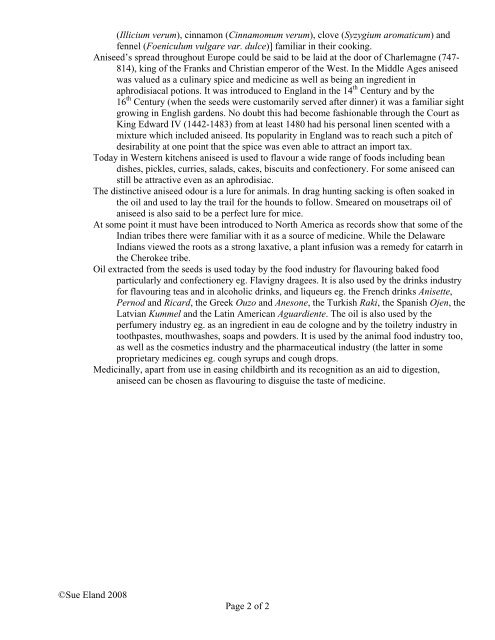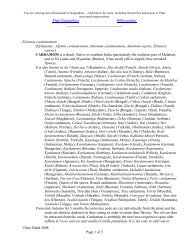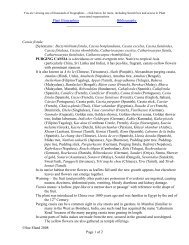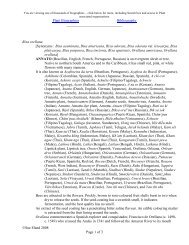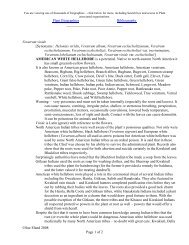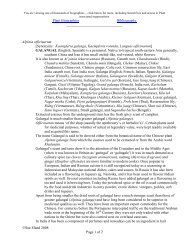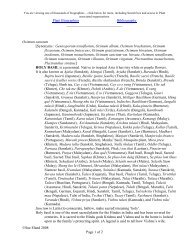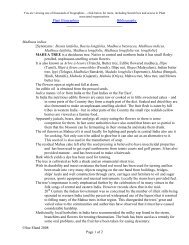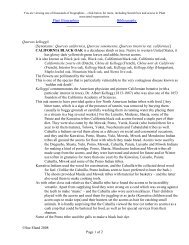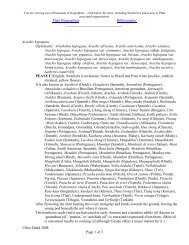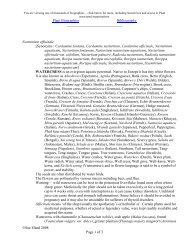You are viewing one of thousands of ... - Plant Biographies
You are viewing one of thousands of ... - Plant Biographies
You are viewing one of thousands of ... - Plant Biographies
You also want an ePaper? Increase the reach of your titles
YUMPU automatically turns print PDFs into web optimized ePapers that Google loves.
(Illicium verum), cinnamon (Cinnamomum verum), clove (Syzygium aromaticum) and<br />
fennel (Foeniculum vulg<strong>are</strong> var. dulce)] familiar in their cooking.<br />
Aniseed’s spread throughout Europe could be said to be laid at the door <strong>of</strong> Charlemagne (747-<br />
814), king <strong>of</strong> the Franks and Christian emperor <strong>of</strong> the West. In the Middle Ages aniseed<br />
was valued as a culinary spice and medicine as well as being an ingredient in<br />
aphrodisiacal potions. It was introduced to England in the 14 th Century and by the<br />
16 th Century (when the seeds were customarily served after dinner) it was a familiar sight<br />
growing in English gardens. No doubt this had become fashionable through the Court as<br />
King Edward IV (1442-1483) from at least 1480 had his personal linen scented with a<br />
mixture which included aniseed. Its popularity in England was to reach such a pitch <strong>of</strong><br />
desirability at <strong>one</strong> point that the spice was even able to attract an import tax.<br />
Today in Western kitchens aniseed is used to flavour a wide range <strong>of</strong> foods including bean<br />
dishes, pickles, curries, salads, cakes, biscuits and confecti<strong>one</strong>ry. For some aniseed can<br />
still be attractive even as an aphrodisiac.<br />
The distinctive aniseed odour is a lure for animals. In drag hunting sacking is <strong>of</strong>ten soaked in<br />
the oil and used to lay the trail for the hounds to follow. Sme<strong>are</strong>d on mousetraps oil <strong>of</strong><br />
aniseed is also said to be a perfect lure for mice.<br />
At some point it must have been introduced to North America as records show that some <strong>of</strong> the<br />
Indian tribes there were familiar with it as a source <strong>of</strong> medicine. While the Delaw<strong>are</strong><br />
Indians viewed the roots as a strong laxative, a plant infusion was a remedy for catarrh in<br />
the Cherokee tribe.<br />
Oil extracted from the seeds is used today by the food industry for flavouring baked food<br />
particularly and confecti<strong>one</strong>ry eg. Flavigny dragees. It is also used by the drinks industry<br />
for flavouring teas and in alcoholic drinks, and liqueurs eg. the French drinks Anisette,<br />
Pernod and Ricard, the Greek Ouzo and Anes<strong>one</strong>, the Turkish Raki, the Spanish Ojen, the<br />
Latvian Kummel and the Latin American Aguardiente. The oil is also used by the<br />
perfumery industry eg. as an ingredient in eau de cologne and by the toiletry industry in<br />
toothpastes, mouthwashes, soaps and powders. It is used by the animal food industry too,<br />
as well as the cosmetics industry and the pharmaceutical industry (the latter in some<br />
proprietary medicines eg. cough syrups and cough drops.<br />
Medicinally, apart from use in easing childbirth and its recognition as an aid to digestion,<br />
aniseed can be chosen as flavouring to disguise the taste <strong>of</strong> medicine.<br />
©Sue Eland 2008<br />
Page 2 <strong>of</strong> 2


